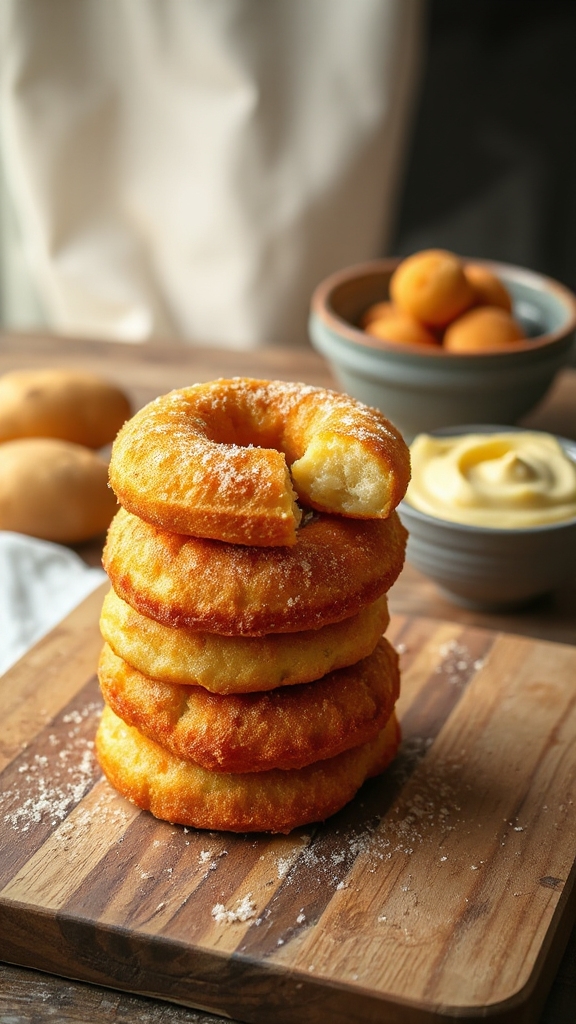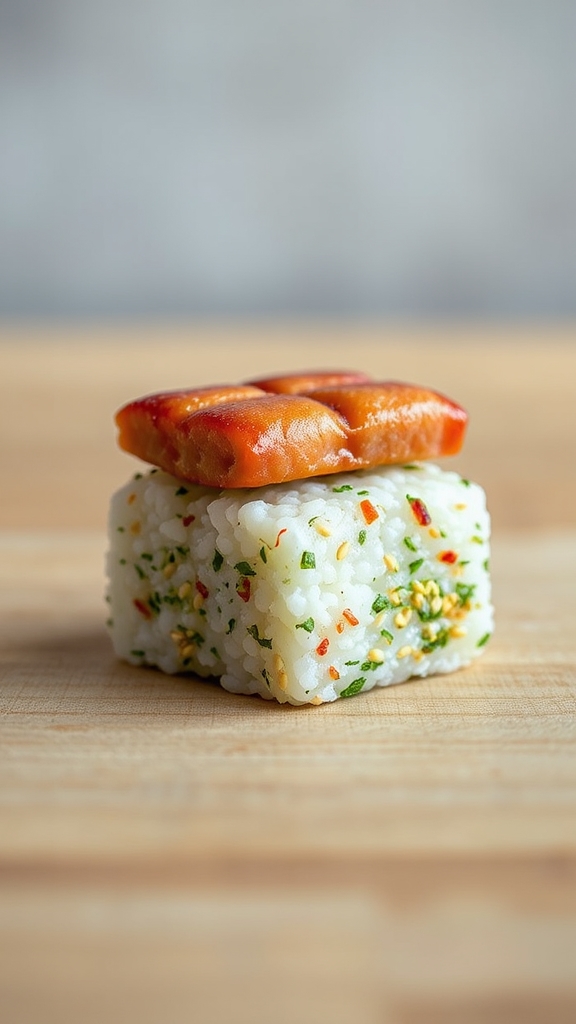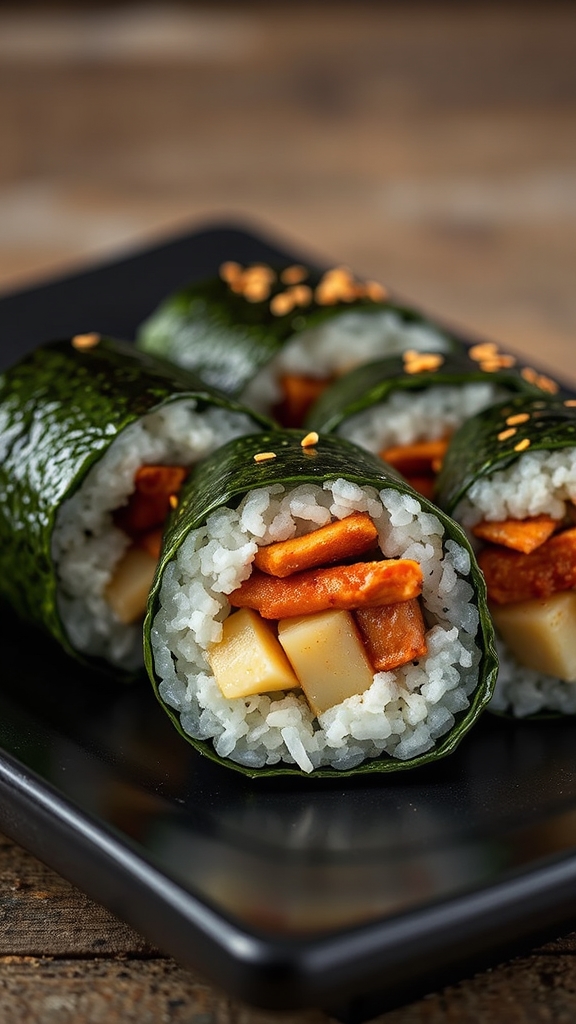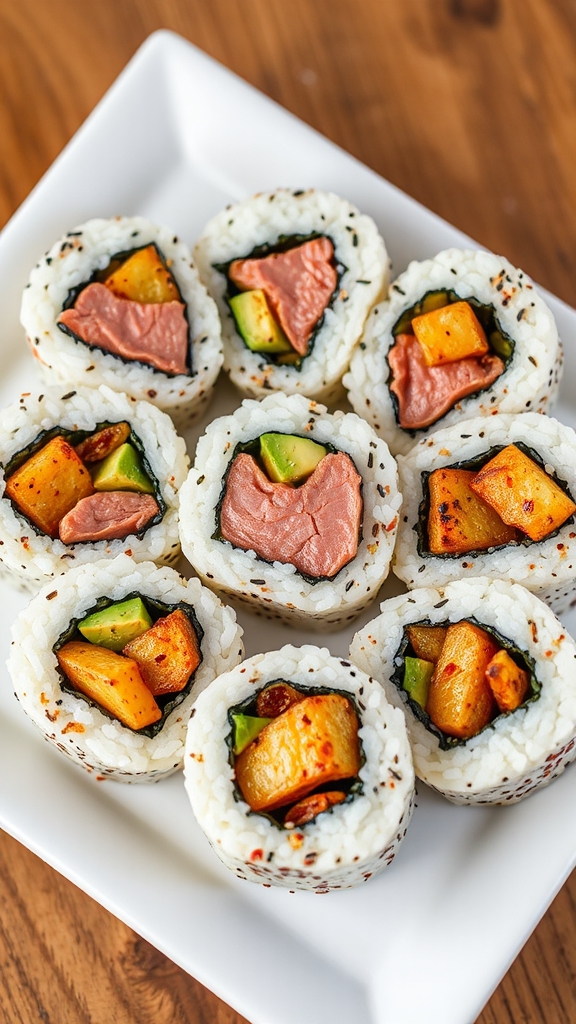Spam Sushi Rolls With Furikake Rice
Nosh on Spam Sushi Rolls with Furikake Rice for a savory-sweet twist that will leave you craving more secrets to perfect your own.

I whip up Spam Sushi Rolls with Furikake Rice as my favorite Hawaiian-Japanese fusion snack, born in mid-20th century Hawaii from post-WWII influences and sushi traditions. I use canned Spam for that savory kick, short-grain rice mixed with furikake for umami, nori for wrapping, and a soy-sugar glaze for sweetness. Frying and assembling is simple and fun. Check out the tips and variations coming up to make yours even better.
History
Spam Sushi Rolls with Furikake Rice originated in Hawaii during the mid-20th century, blending Japanese sushi traditions with American influences like canned Spam, which became widespread after World War II as a symbol of resourcefulness in Hawaiian cuisine.
Regional variations include the classic Spam musubi in Hawaii, often topped with furikake for added flavor, signifying the islands’ multicultural fusion and adaptability; in Japan, similar rolls might incorporate local ingredients for a more authentic twist, highlighting cross-cultural exchanges.
Traditionally, this dish is served as a convenient snack at casual gatherings, beach outings, or everyday meals in Hawaii, reflecting its role in the laid-back island lifestyle rather than formal occasions.
Ingredients
– Canned Spam (about 12 ounces, sliced into thick strips): Oh, you can’t talk Spam sushi without this star player, can you?
It’s that trusty, pre-cooked can of goodness that brings a savory punch, making me wonder how something so simple turned into a Hawaiian favorite—maybe it’s the way it crisps up just right, without me needing to fuss over fresh meat.
– Short-grain rice (2 cups uncooked, yielding about 4 cups cooked): Imagine this, fluffy and sticky rice as the base, holding everything together like a trusty sidekick.
Because who doesn’t love that chewy texture that soaks up flavors, turning a plain roll into something special with just a bit of effort?
– Furikake seasoning (2-3 tablespoons, your favorite blend): This magical mix of seaweed, sesame, and a dash of salt adds that umami kick, doesn’t it?
It’s like sprinkling a little Hawaiian magic on top, where every pinch makes you pause and think, why didn’t I discover this sooner for my rolls?
– Nori sheets (4-6 sheets, depending on how many rolls you’re making): These crisp seaweed wrappers are the unsung heroes, wrapping it all up neat and tidy.
Almost like they’re saying, hold on tight, without stealing the show from the rest.
– Soy sauce (2 tablespoons, for glazing or dipping): A splash of this salty liquid brings depth, you know, turning ordinary into oh-so-tasty.
It’s that everyday pantry item that sneaks in and elevates things, even if I’m still figuring out the perfect pour.
– Sugar (1 tablespoon, mixed into the glaze): Just a touch of sweetness to balance the Spam’s savoriness, because let’s face it, life’s too bland without a little contrast.
Though I might overdo it sometimes, thinking more is merrier when it’s not.
– 2 medium russet potatoes, peeled and diced into 1/2-inch cubes (about 3 cups): Here’s a quirky addition, those hearty spuds that add a starchy surprise.
Maybe not the first thing you’d expect in sushi rolls, but they bring a comforting bulk, making me chuckle at how they sneak in like uninvited guests who end up fitting right in.
– Optional: Green onions (2-3, finely chopped, for a fresh twist): If you’re feeling fancy, toss these in for a bit of crunch and color.
Because who says rolls have to be basic—it’s like asking, why not add a little extra personality to the mix?
– Optional: Eggs (2, beaten and cooked into a thin omelet, sliced): For those days when you want to layer in some protein, these make a silky addition.
Almost like they’re whispering, let’s keep things interesting without complicating the fun.
– Vegetable oil (2 tablespoons, for frying the Spam and potatoes): This humble helper gets things golden and crisp, you see, preventing any stickiness in the pan.
Though I often second-guess the amount, picturing a greasy mess that never quite happens.
Cooking Steps
Let’s delve into making these Spam sushi rolls, shall we? First off, you’ll want to start with the basics: cook your short-grain rice to get that perfect sticky texture. Rinse 2 cups of uncooked short-grain rice under cold water until it runs clear, then cook it according to the package instructions—usually in a rice cooker or pot with 2.5 cups of water, simmering for about 15-20 minutes until fluffy. Once it’s done, gently mix in 2-3 tablespoons of furikake seasoning while the rice is still warm, letting those seaweed and sesame flavors weave in like a cozy blanket, because who knew a simple sprinkle could turn rice into something so irresistible?
Next, prepare your fillings to build some excitement into the rolls. Begin by frying the canned Spam—about 12 ounces, sliced into thick strips— in a hot skillet with a bit of oil for 3-5 minutes per side until it’s crispy on the edges, that savory punch making you pause and think, is this really from a can?
Don’t forget those 2 medium russet potatoes, peeled and diced into 1/2-inch cubes; boil them in salted water for 10-15 minutes until tender, then drain and mash lightly for a starchy surprise that adds heartiness without stealing the show—almost like inviting an unexpected friend to dinner who fits right in.
If you’re adding optional touches, like beating and cooking 2 eggs into a thin omelet then slicing it, do that now for extra protein.
Finally, assemble your rolls and give them that final flair. Lay out 4-6 nori sheets on a bamboo mat, spread a thin layer of the furikake rice over each, leaving a bit of edge for sealing, then add your fried Spam strips, mashed potatoes, and any extras like finely chopped green onions if you’re in the mood for crunch.
Roll it up tight, like wrapping a gift you can’t wait to open, and slice into bite-sized pieces.
Brush with a glaze of 2 tablespoons soy sauce mixed with 1 tablespoon sugar for a sweet-salty kick, then let it rest for a minute or two—because sometimes, waiting just a touch makes all the difference, even if I tend to rush and end up with a messy roll that still tastes great.
Tips and Variations
If you’re tweaking these Spam sushi rolls, one handy tip is to experiment with the potatoes—try roasting those 2 medium russet ones instead of boiling, dicing them into 1/2-inch cubes and tossing with a little oil for 20-25 minutes until golden and crispy, which adds a fun, unexpected crunch that might just surprise your taste buds and make the roll feel less like a canned adventure.
For variations, why not swap the Spam for grilled chicken or tofu strips if you’re in a lighter mood, or mix in some diced avocado for creaminess alongside the mashed potatoes, because let’s face it, who says sushi has to stick to the script when you can play around and end up with a roll that’s equal parts messy and magnificent, even if my imaginary kitchen escapades always look better on paper than in real life.
Tools
| Tool | Description |
|---|---|
| Vegetable peeler | For peeling the potatoes. |
| Cutting board | For dicing potatoes and other ingredients safely. |
| Knife | For dicing potatoes into 1/2-inch cubes and slicing other components. |
| Pot or saucepan | For boiling the diced potatoes. |
| Colander or strainer | For draining boiled potatoes. |
| Mixing bowl | For mashing or mixing ingredients. |
| Bamboo sushi mat | For rolling the sushi rolls. |
| Sharp knife | For cutting the rolled sushi into pieces. |
| Measuring cups and spoons | For accurately measuring ingredients like rice or seasonings. |
| Spatula or spoon | For stirring and handling mixtures. |

Hi There! I'm Stephanie Miller: Elementary teacher from Columbus, OH sharing grandma's treasured American recipes! 50 years young, yoga enthusiast & kitchen storyteller. Welcome to my food family! 🍰❤️












